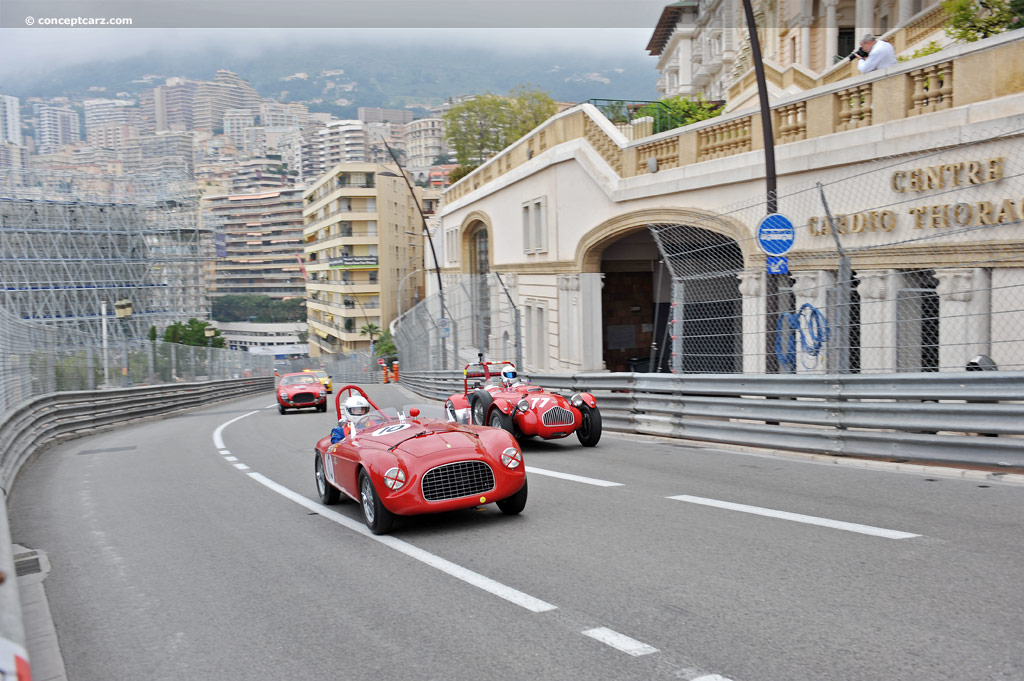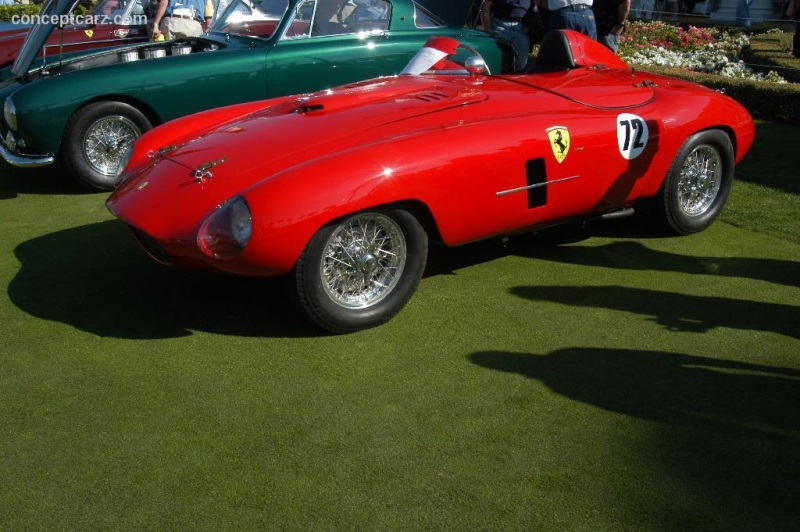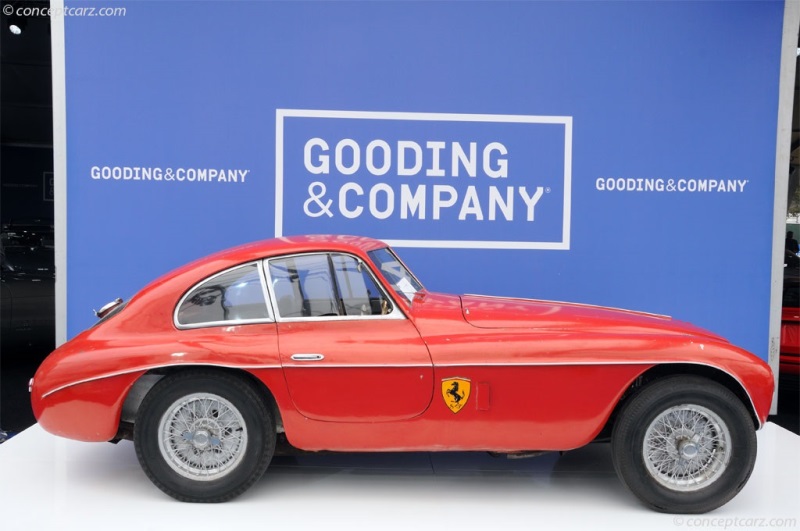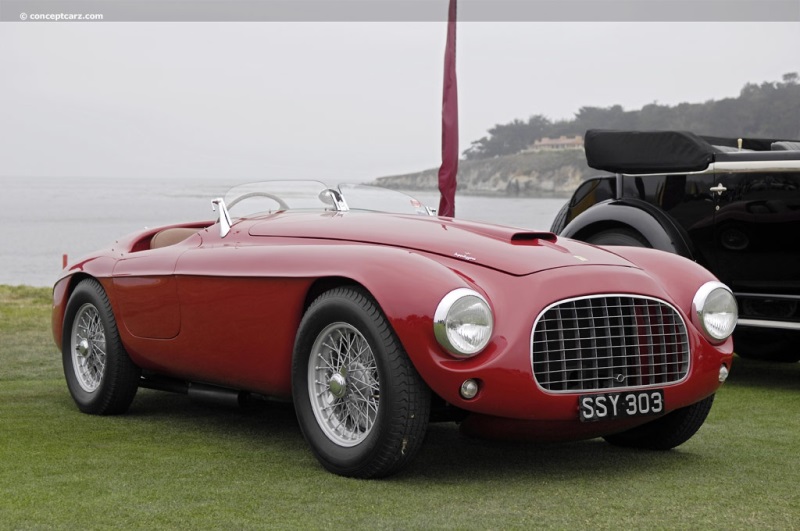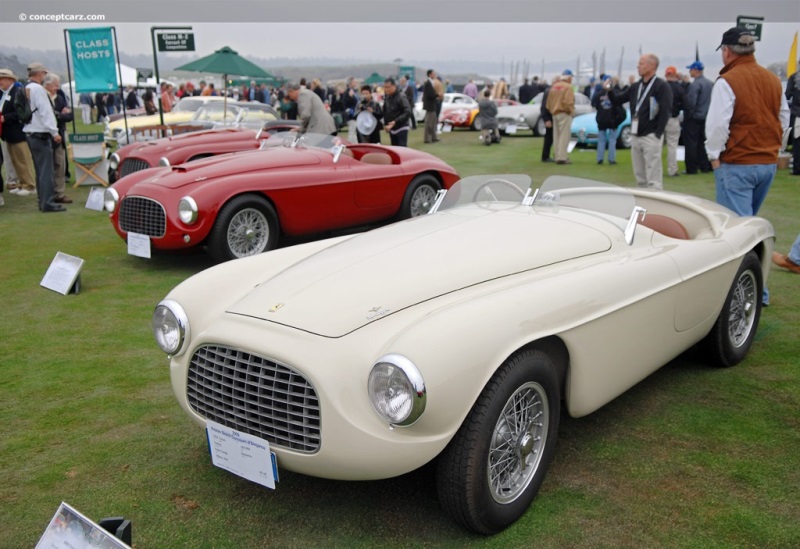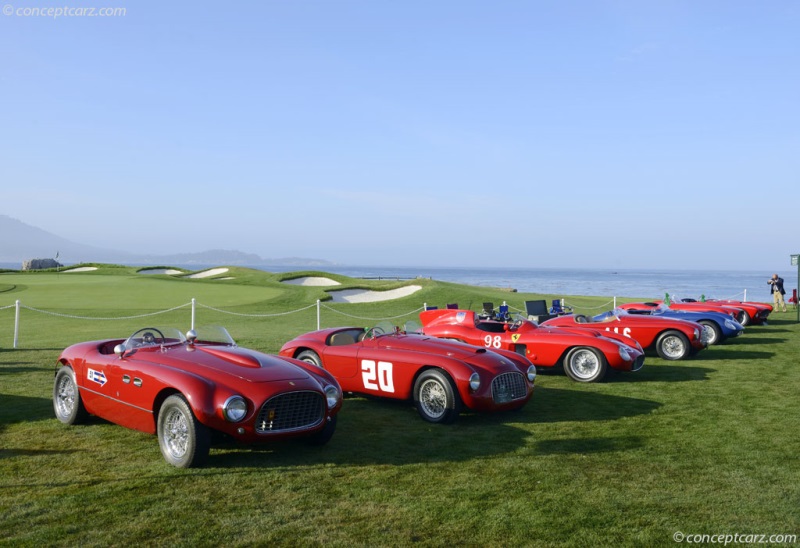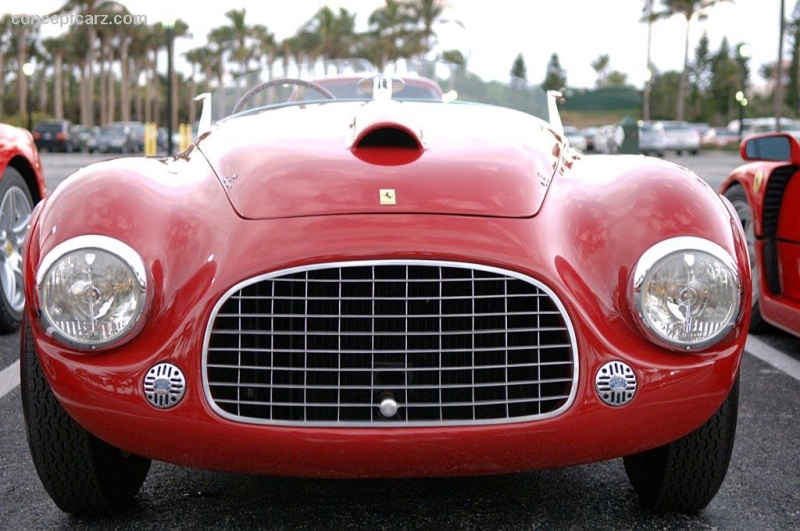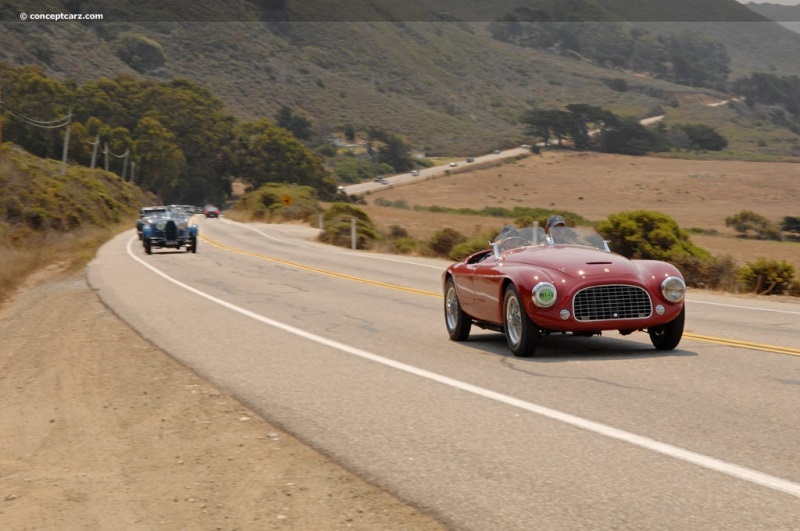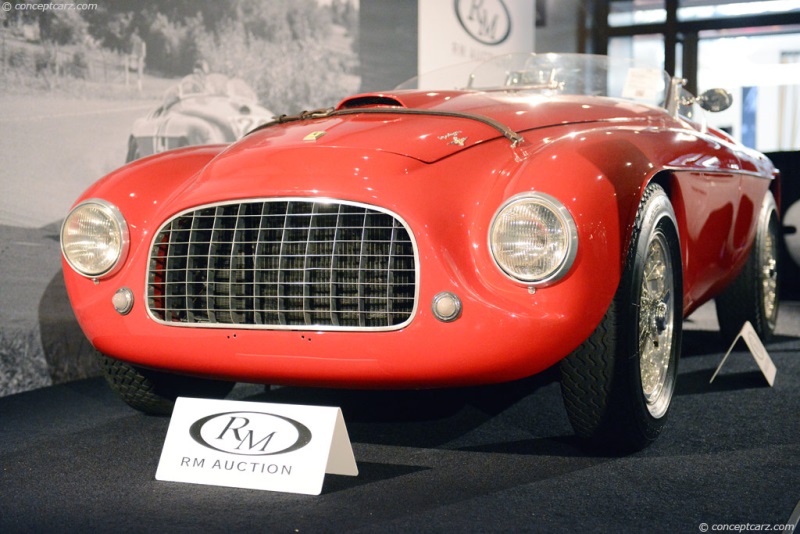1950 Ferrari 166MM Navigation
History
Clemente Biondetti and Count Igor Troubetzkoy won the Targa Florio on April 3rd of 1948, marking Ferrari's first major international win. The car was a closed Berlinetta Ferrari 166 and would later capture a victory at Italy's most important race, the Mille Miglia in 1948.
The Ferrari 166 was officially introduced at the Turin Salon in September of 1948. The body was courtesy of Touring utilizing the patented 'superleggera' technique. The alloy coachwork was well proportioned, covering the narrow tube skeleton structure. The frame consisted of an oval tube cross-section ladder with an X-shaped cross member. The short wheelbase car was given a Giacchino Colombo-designed V12, which would become the basic structure that would serve Ferrari road and race car for the next two decades.
In total, there were a mere 33 examples of the 166 MM produced between 1949 and 1951. Most of the 166 models were given Carrozzeria Touring coachwork in either Barchetta or Berlinetta forms. 26 were Barchettas and 7 were Berlinetta models. Of the seven Touring-bodied Berlinettas, only five were the Le Mans Berlinettas, named for Ferrari's victory at the 1949 24 Hours of Lemans in a 166MM.
By Daniel Vaughan | Mar 2009
The Ferrari 166 was officially introduced at the Turin Salon in September of 1948. The body was courtesy of Touring utilizing the patented 'superleggera' technique. The alloy coachwork was well proportioned, covering the narrow tube skeleton structure. The frame consisted of an oval tube cross-section ladder with an X-shaped cross member. The short wheelbase car was given a Giacchino Colombo-designed V12, which would become the basic structure that would serve Ferrari road and race car for the next two decades.
In total, there were a mere 33 examples of the 166 MM produced between 1949 and 1951. Most of the 166 models were given Carrozzeria Touring coachwork in either Barchetta or Berlinetta forms. 26 were Barchettas and 7 were Berlinetta models. Of the seven Touring-bodied Berlinettas, only five were the Le Mans Berlinettas, named for Ferrari's victory at the 1949 24 Hours of Lemans in a 166MM.
By Daniel Vaughan | Mar 2009
It was in 1948 when the newly formed Italian automobile company named Ferrari began selling a promising sports car named the 166. The two-seater sports car featured a 12-cylinder engine mounted in the front and supplying over 100 horsepower to the rear wheels. The engine was just under two-liters in size and had a unitary displacement of 166 cc, thus, the evolution of the model name. Production would last until 1953 with only 38 examples being produced. Even though production was low, its accomplishments are large, with wins at LeMans, Mille Miglia, and the Targa Florio.
The 166 was a continuation of the 125, introduced a year earlier. The 125's size of 1497 cc was later enlarged to 1902cc, bringing about the Tipo 159. In 1948, it was enlarged to 1995 cc and became the 166.
As was customary at the time, a rolling chassis was supplied to custom coachbuilders to outfit the vehicles according to customer specifications and their intended purposes. The 166 MM was named after its historic victories at the Mille Miglia. The 166 MM versions were given even chassis numbers and built with racing intentions. The 166 Inter, named after victories at the Coppa Intereuropa at Monza, were given odd chassis numbers and became Ferrari's first road car.
The 166 Inter road cars featured a 2 liter, 12-cylinder Colombo engine producing about 115 horsepower. The engines were mounted longitudinally and given one Weber 32 DCF Carburetor. A five-speed manual gearbox provided power to the rear wheels while drum brakes provided the stopping power. Top speed was achieved at just over 105 mph. Zero-to-sixty took about ten seconds. The tubular frame was given a live-rear axle and a front wishbone suspension. When production began, Carrozzeria Touring was the primary coachbuilder, outfitting the cars in both Berlinetta and Coupe bodies. Later, other coachbuilders such as Pinin Farina, Ghia, Vignale, and others, produced bodies for the 166 Inter.
The phenomenal accomplishments achieved on the race track did much to stir enthusiasm for the cars. To generate even more publicity, in November of 1948, Ferrari displayed examples of his 166 MM and 166 Inter Coupe at the Turin Motor Show. Other shows included the Paris salon in October of 1950 and the Geneva Salons in March of 1951.
With just 38 examples created, the 166 Inter was replaced in 1950 by the 195 Inter. The 195 Inter came into existence by the enlargement of the engine to 2.3 liters. A year later the engine was enlarged to 212 cc and the name changed to 212 Inter. In 1952, after 142 examples were created, production ceased.
166 MM
The 166 MM was a competition version of the 166 Inter. It featured the same 12-cylinder engine but modified to produce 135 horsepower. The suspension and chassis were similar to the 166 Inter. The bodies were lightweight, small, and built to endure the grueling requirements that racing requires. Initially, Ferrari intended the 166 MM to be a customer racing car. After a number of 166 MM models captured a large number of class and overall victories against stiff competition such as Maserati, Cistiralia, and Alfa Romeo, Ferrari commissioned the creation of the 166 MM as factory works cars.
Touring of Italy was commissioned to provide the coachwork for most of the 166 MM, and many were given Barchetta bodies. The name 'Barchetta' came about because of the size and design of the car. Barchetta in Italian means little boat.
Clemente Biondetti and Giuseppe Navone drove a 166 MM to overall victory at the Mille Miglia in 1948. A year later, Biondetti and Ettore Salani captured the victory at Mille Miglia in a 166 MM. Giannino Marzotto and Marco Crosara capture victory at Mille Miglia in 1950, driving a 166 chassis with a bigger 195 engine. In 1949 a Ferrari 166 MM, entered by Lord Selsdon and mostly driven by Luigi Chinetti, captured overall victory at Le Mans.
The 166 MM's were a powerful, reliable and competitive automobile. Their historic accomplishments are legendary and their designs are elegant, beautiful and breathtaking. VIN #002C, a 166 Spyder Corsa, is the oldest Ferrari car still in existence.
By Daniel Vaughan | Feb 2007
The 166 was a continuation of the 125, introduced a year earlier. The 125's size of 1497 cc was later enlarged to 1902cc, bringing about the Tipo 159. In 1948, it was enlarged to 1995 cc and became the 166.
As was customary at the time, a rolling chassis was supplied to custom coachbuilders to outfit the vehicles according to customer specifications and their intended purposes. The 166 MM was named after its historic victories at the Mille Miglia. The 166 MM versions were given even chassis numbers and built with racing intentions. The 166 Inter, named after victories at the Coppa Intereuropa at Monza, were given odd chassis numbers and became Ferrari's first road car.
The 166 Inter road cars featured a 2 liter, 12-cylinder Colombo engine producing about 115 horsepower. The engines were mounted longitudinally and given one Weber 32 DCF Carburetor. A five-speed manual gearbox provided power to the rear wheels while drum brakes provided the stopping power. Top speed was achieved at just over 105 mph. Zero-to-sixty took about ten seconds. The tubular frame was given a live-rear axle and a front wishbone suspension. When production began, Carrozzeria Touring was the primary coachbuilder, outfitting the cars in both Berlinetta and Coupe bodies. Later, other coachbuilders such as Pinin Farina, Ghia, Vignale, and others, produced bodies for the 166 Inter.
The phenomenal accomplishments achieved on the race track did much to stir enthusiasm for the cars. To generate even more publicity, in November of 1948, Ferrari displayed examples of his 166 MM and 166 Inter Coupe at the Turin Motor Show. Other shows included the Paris salon in October of 1950 and the Geneva Salons in March of 1951.
With just 38 examples created, the 166 Inter was replaced in 1950 by the 195 Inter. The 195 Inter came into existence by the enlargement of the engine to 2.3 liters. A year later the engine was enlarged to 212 cc and the name changed to 212 Inter. In 1952, after 142 examples were created, production ceased.
166 MM
The 166 MM was a competition version of the 166 Inter. It featured the same 12-cylinder engine but modified to produce 135 horsepower. The suspension and chassis were similar to the 166 Inter. The bodies were lightweight, small, and built to endure the grueling requirements that racing requires. Initially, Ferrari intended the 166 MM to be a customer racing car. After a number of 166 MM models captured a large number of class and overall victories against stiff competition such as Maserati, Cistiralia, and Alfa Romeo, Ferrari commissioned the creation of the 166 MM as factory works cars.
Touring of Italy was commissioned to provide the coachwork for most of the 166 MM, and many were given Barchetta bodies. The name 'Barchetta' came about because of the size and design of the car. Barchetta in Italian means little boat.
Clemente Biondetti and Giuseppe Navone drove a 166 MM to overall victory at the Mille Miglia in 1948. A year later, Biondetti and Ettore Salani captured the victory at Mille Miglia in a 166 MM. Giannino Marzotto and Marco Crosara capture victory at Mille Miglia in 1950, driving a 166 chassis with a bigger 195 engine. In 1949 a Ferrari 166 MM, entered by Lord Selsdon and mostly driven by Luigi Chinetti, captured overall victory at Le Mans.
The 166 MM's were a powerful, reliable and competitive automobile. Their historic accomplishments are legendary and their designs are elegant, beautiful and breathtaking. VIN #002C, a 166 Spyder Corsa, is the oldest Ferrari car still in existence.
By Daniel Vaughan | Feb 2007
- 1950 Ferrari 166MM Menu
- Article
- Image gallery
- Valuation
- Specifications
- Profiles
- Production figures
1950 Ferrari 166MM Vehicle Profiles
Recent Vehicle Additions
Related Automotive News

Unique 1950 Ferrari 166MM/212 Export 'Uovo' to star in the 2024 Salon Privé Concours presented by Aviva Private Clients
Salon Privé Concours presented by Aviva Private Clients at Blenheim Palace welcomes a unique 1950 Ferrari 166MM212 Export Uovo
Led the 1951 Mille Miglia and won the Coppa della Toscana the same year
A rare opportunity to enjoy a car seldom see...

Remarkably Pure Ferrari 166 MM Completes RM Sotheby's Stellar Offering at Amelia Island
RM Sothebys rounds out superlative Amelia Island catalogue with an exceptionally pure 1950 Ferrari 166 MM Barchetta
A two-time Mille Miglia entrant, chassis 0058 M is the latest in a series of multi-million-dollar entries confirmed for RM Sotheb...

1962 Ferrari 250 GT SWB California Spider to Lead Gooding & Company's Amelia Island Auctions Alongside Stable of the Finest Ferraris
The star car of the auctions will be a one-off 1962 Ferrari 250 GT SWB California Spider, joined by a 250 GT Tour de France Berlinetta, a 250 MM Vignale Spider, and other examples of Maranellos finest models.
Leading international auction...

Phenomenal Ferraris and Italian Thoroughbreds Offered at Gooding & Company's Pebble Beach Auctions
The auction house announced a stable of Italian star cars, including a 1950 Ferrari 166 MM Berlinetta Le Mans, a 1961 Ferrari 400 Superamerica Series I Coupe Aerodinamico, and a 1954 Ferrari 500 Mondial Series I Spider.
A stunning group of star...

Ex-Scuderia Ferrari Alfa Romeo 8C 2300 Monza Spider By Zagato Scoops Best Of Show At Salon Privé
Alfa Romeo 8C 2300 Monza Spider by Zagato raced by Tazio Nuvolari wins top award
Leading designers present inaugural Churchill Cup to rare Lancia Astura
Duke of Marlborough selects his favourites on two wheels and four
Record entry for the UKs...

2015 Pebble Beach Concours d'Elegance Best of Show
PEBBLE BEACH, Calif. (August 17, 2015) -- An Italian Isotta Fraschini Tipo 8A Cabriolet that once turned heads and garnered top prizes in the classic era glided to victory at the 65th Pebble Beach Concours dElegance on Sunday.
The competition...
1956 Argentine Grand Prix: Least in the Kingdom is Greater
Speaking of the power of humility, the Bible says the least, within the context of the world, if they follow Gods commands, shall be greater than those considered great.
To say that Luigi Musso was the least within the kingdom of Scuderia Ferrari...
